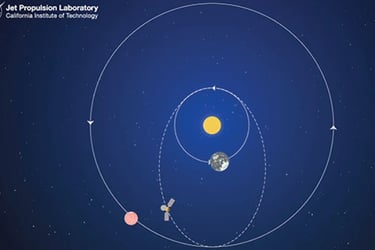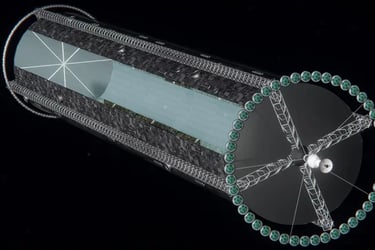The Lunar Launch Ring, redefines interplanetary travel with a solar powered maglev rail encircling the moon’s equator. This 6,792km track leverages the moon’s low gravity, lack of atmosphere, and abundant solar energy to launch spacecraft efficiently. The system serves three purposes: a luxurious Hohmann Transfer Cylinder for human travel, a high speed Cargo Launcher for rapid Martian resupply, and a long-term Interstellar Ark for voyages beyond our solar system. Built with lunar robotics and powered by perpetual sunlight, the Launch Ring makes Mars colonization easy and interstellar dreams possible.
The Lunar Launch Ring
Cargo Launcher: The Cargo Launcher is the Lunar Launch Ring’s rapid-response system, firing uncrewed payloads to Mars at 15,000 -50,000 miles per hour (depending how fast you want to get there, and how much braking fuel you want to carry.) Unlike the human-friendly cylinder, this mode prioritizes speed over comfort, enabling emergency resupply to Martian colonies anytime—not just during Hohmann windows. Using the same maglev rail, cargo pods—rugged, streamlined sleds—are accelerated in a vacuum-sealed track, reaching speeds that sling them into a high-energy transfer orbit. The trip takes just 30–60 days, depending on Mars’ position relative to Earth. On arrival, chemical thrusters and aerobraking slow the pods, with parachutes or retro-rockets handling the final descent. This system eliminates the need for precise orbital alignments, ensuring colonies get critical supplies like medical equipment or food during emergencies. The rail’s efficiency, powered by lunar solar arrays and built with regolith-based composites, allows daily launches. Each pod carries up to 100 tons, from habitat modules to water tanks, making Mars resupply as routine as a freight train. No humans, no G-force limits—just raw, reliable delivery.
Interstellar Ark: Looking a thousand years ahead, the Interstellar Ark transforms the Lunar Launch Ring into humanity's gateway to the stars. This massive, city-sized vessel-potentially 100,000 tones-is constructed on the moon using advanced robotics and local resources. Launched at 60 km/s (37,282 mph), the Ark rides the moon's 3.68 km/s (2,288 mph) orbit around Earth, stacking on Earth's 107 km/s (66,616 mph) solar orbit, to total escape velocity of 207 km/s (129,000 mph). The maglev rail-upgraded with next-gen superconductors and carbon-regolith composites-manages the 10-g sideways kick. For launch, you hug the moon for 6,000 km at 1 g, then in the final 4 km rise on a 5° straight ramp-no centrifugal 42-g slap. The last kilometer curves gently at 7,345 km radius: at peak speed you take 10 g outward + 1 g forward = 11 g burst, reclined in gel harness. Humans live, cargo doesn't notice. The ramp tops 100 km high-regolith-foam arch, solar-trussed, like a ski jump to Alpha Centauri. Inside: hydroponics, fission micro-reactors, three-generational corridors for thousands. Single-shot or multi-loop acceleration slings it out-no return ticket. The moon's vacuum and 1/6 g made this possible. Same ring, bigger dreams.
Why It Works: The Lunar Launch Ring combines efficiency and scalability. Solar power and lunar materials slash costs, while the maglev rail eliminates fuel-heavy launches. The Hohmann Cylinder ensures safe, comfortable human travel; the Cargo Launcher keeps Mars stocked; and the Interstellar Ark opens the stars. The moon isn’t just a rock—it’s our highway hub.
Mars in the meantime (Terraforming Prelude, aka "the gold bomb"): Nudge 16 Psyche, the 226 km diameter M-type asteroid rich in iron-nickel-gold alloy into Mar's south pole Estimated gold content: ~10 billion tones, or 10¹¹ USD at current pricing-enough to seed an off world economy. At the same time you vaporize 10¹⁶ kg of CO₂ and water, thickening the air in weeks. Gold rains down as the ice melts, pooling in new rivers-prospectors mine it before the steam clears. North pole? Keep it clean-save the water for oceans. Phase Four kicks in after: launch cargo, build the ark. First, make Mars worth crashing into.


Hohmann Transfer Cylinder: Imagine a vast, 1.8 km diameter spinning cylinder, spun at one revolution per minute for Earth-like gravity without queasiness. The Hohmann Transfer Cylinder is a floating city, built on the moon using Phase Three’s robotic factories. Its walls, packed with ten meters of water-ice shielding, block cosmic rays, ensuring passenger safety during the six-month journey to Mars. Wide decks house hydroponics, gyms, and communal spaces, making the trip feel like a cruise, not a commute. Launched at a gentle 800 miles per hour from the Lunar Launch Ring, the cylinder enters a stable Hohmann transfer orbit—a two-year ellipse syncing with Earth and Mars every 26 months. Small Starship shuttles ferry passengers from Earth to the cylinder, docking in low lunar orbit. At Mars, compact landers detach, aerobraking and parachuting to the surface. The cylinder never stops, coasting perpetually with minimal fuel for station-keeping. It’s the ultimate human ferry: safe, spacious, and sustainable, carrying thousands to Mars with room to stretch and zero radiation worries.





